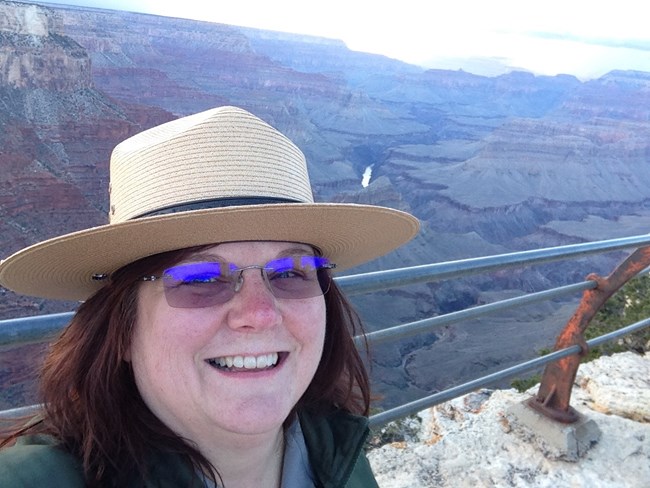Last updated: February 22, 2023
Article
2018 Engineers Week: Kris Provenzano, Project Manager, Denver Service Center Design and Construction Division

Photo courtesy Kris Provenzano
Name/Title: (Retired) Kris Provenzano, Project Manager, Denver Service Center Design and Construction Division
Please share the most challenging engineering project you have been involved with in the recent past.
As the Denver Service Center's (DSC) Grand Canyon Program Manager for the past year and during multiple details as Grand Canyon’s Chief of Facility Management, I’ve become involved in many challenging projects. The Canyon’s critical drinking water supply and distribution systems and wastewater treatment systems are aging and failing. Any day can become the most challenging when a critical pump fails, the waterline breaks, or the inner canyon main electrical line grounds out. Probably the most recognizable project at the park is the replacement of the Trans-canyon Waterline.
The existing 12.5-mile long waterline is more than 50 years old and is the sole delivery system for water to the inner canyon and to the entire South Rim of the Grand Canyon. The system provides water to nearly six million visitors each year and a community of over 2,500 year round residents including a school. Built in the 1960’s, it was lauded as an engineering marvel. It is really a simple and elegant system. A pipeline that funnels water, via gravity, from Roaring Springs on the north side of the Grand Canyon down Bright Angel Canyon, across the Colorado River, up to the Indian Garden pump house. That pump house has been in operation since 1932. From Indian Garden, the water is pumped up the last 3,000 feet to a 14-million gallon storage facility on the South Rim, about two weeks’ worth of storage.
Today the waterline breaks, on average, once a month. Just recharging the fragile line can cause a break. Grand Canyon has names for the breaks, bubblers are generally left bubbling, but gushers and sprayers need to be fix immediately. The pressure on the waterline is over 700 pounds per square inch at the bottom of the canyon, think pressure washer in the middle of a trail. So we need to replace it, and then the question, becomes with what?
Through value analysis, we’ve identified a solution and are evaluating it through the NEPA process, the Environmental Assessment will be out for public review this summer. We are looking at relocating the source of water to the bottom of the Canyon at Phantom Ranch. Seven miles of waterline will be abandoned. Water will be pushed by new pumps at Phantom Ranch 5-miles uphill to Indian Garden; and we will need to add water treatment plants at three locations, two in the inner canyon and one on the South Rim.
Managing logistics and public expectations are the most challenging element to the projected 3.5 year project. The only transportation into the canyon is by foot, mule, or helicopter. We are estimating more than 3,000 helicopter flights into an area where natural sounds are cherished. We need to identify locations we can house construction crews on the rim and in the inner canyon with minimum impacts to the environment and the visitors. And we will be closing sections of the most popular trails for up to a year. There is a lot to figure out during the next 18 months, we’re anticipating beginning construction in late 2019.
What checks and balances do you use to make sure your project meets Park Service's needs while staying within available funding and specified time frames?
I believe it is important to step back from any process or project from time to time to assure it is progressing toward the goals that were set during the planning process and to make sure those goals are still valid. Refocusing on the “big picture” and using that to managing the expectations of the stakeholders has helped me in the past. Asking questions like “How does this change help meet or exceed the goal?” or “What is the risk versus the benefit or return on investment of the action?” have helped me refocus people (and myself) from saying “I want it” to asking “Do I need it?”
What are you doing to stay current with the latest technology?
I am a bit of a research junky and spend time surfing the web and reviewing journals for needed information, but the best source is the wealth of knowledge from the folks at Denver Service Center; it is great working with so many dedicated professionals who are always willing to talk though a problem.
What does a typical day look like for you?
A lot like a computer screen, a telephone, and a conference room. I am lucky to be working on few high profile projects and lately there are many quick turnaround information requests for the FY19 budget; so they come first each day. In general, my day is filled with writing scopes, reviewing submittals, gathering, and coordinating project information and budgets with the park, the region, the consultant, and/or contractors. As the Grand Canyon program manager, I spend a fair amount of time providing technical assistance in project development and scoping.
What do you enjoy most about your job as an engineer?
When I choose engineering as a major, I never realized how many doors would be open. In my 25 years with the NPS, I have held positions at parks, regions, and WASO. I love the variety of work and the challenges and rewards of each job.
